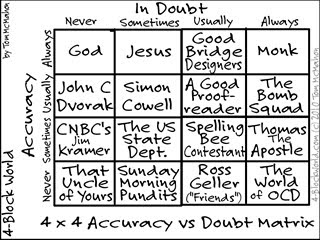We're sure you've all heard of the Goldman Sachs Abacus scandal, but most folks don't really understand what it means. Well, Goldman created a CDO called Abacus and sold it to its clients. But Goldman forgot to tell its clients that Abacus was designed to fail. Meanwhile, Goldman had placed numerous side bets that it would do just that. It was like "The Producers," that movie in which some dudes raise a mint to put on a show destined to bomb, intent on pocketing the investment money.
But most folks have no idea what a CDO is, what the hell is a derivative. Trust us. We have worked in (or very close to) financial services for eight years. Ask anyone to explain a default swap. Watch them stammer and bullshit. They don't know either. We can only tell you they appear to be an unholy hybrid between an insurance policy and a side bet at a cockfight.
So to help us understand what went down at Goldman Sachs, we've enlisted infamous children's book writer Nurse Noose to explain it to us as if we were five. And here it is:
GOLDMAN SELLS A WHATZIT
In the land of Maglop, just south of Canack
A rich man named Goldman McSachy-McGlack
Arrived into town with a large golden sack
It was stuffed full of whatzits and slung on his back
The foos that inhabit the land of Maglop
Watched as McSachy-McGlack set up shop
The new shop was chic, it was shiny, compelling
"What are you selling?" the foos started yelling
McSachy-McGlack smiled and answered the foos:
"Come see for yourself, you've got nothing to lose."
Inside the shop, there was box upon box
And each box was locked up with five golden locks
"What is it?" they asked, their eyes bright with greed
"It's a whatzit, that's what, and it's just what you need"
"What does it do?" asked young Cindy-lu Foo
"Well" said McSachy-McGlack "I'll tell you"
"It makes the poor rich, and it makes the rich richer
And the richest more richester, now get the picture?
Just buy one or two, put them under your bed
And leave them alone, get them out of your head
And then sell them back, and worse comes to worst
They will be worth ten times what they cost you at first"
"But" he continued "there's one caveat"
The impatient foos said in unison "what?"
"The whatzit will work only if it stays locked"
"What's in a whatzit?" the older foos mocked
"It doesn't concern you, just don't open the box
Keep it under your bed, and don't unlock the locks"
"I'll take one" said one foo "I'll take three or four"
"I'll take a dozen" "put me down for a score!"
Each foo soon had his own whatzit stash
And each knew that soon they'd be rolling in cash
So they bought foo-mobiles and they mortgaged their huts
They had foo boob jobs and foo liposucked butts
What happened next? Well, what do you think?
The whatzits, one-by-one, started to stink
They reeked to high heaven, all icky and rank
Like bungle-beast farts, that's how much they stank
The foos plugged their noses, they cursed and they swore
Til Cindy-lu Foo couldn't take anymore
She took out her whatzit and unlocked the locks
She took a deep breath and she opened the box
What was inside? Well I've got the scoop:
Each whatzit was stuffed full of snorgle-pig poop
When word got around, every foo would lament
"My whatzit portfolio aint' worth a cent!"
They soon lost their jobs, and then lost their houses.
They started to drink, they were beating their spouses
By the time they were left with no foo-pot to piss in
Goldman McSachy-McGlack turned up missin'
What happened then? It just keeps getting better
Taped to his boarded up shop was a letter
"I'm sorry you're left with nary a cent
But look on the bright side! I've made a mint!
See, to tell you the truth (and I know the truth hurts)
I placed a side bet that the Foos lose their shirts."
"The moral" it said "you should know now by heart:
A foo and his money are destined to part"
-Can O' Whup Ass
for more:
http://canofwhupass.typepad.com/my_weblog/
 The San Franciso Peregrine falcon couple on the PG&E building had four fledglings this year. All doing well so far. Here's a shot of one of the males (tiercel).
The San Franciso Peregrine falcon couple on the PG&E building had four fledglings this year. All doing well so far. Here's a shot of one of the males (tiercel).



